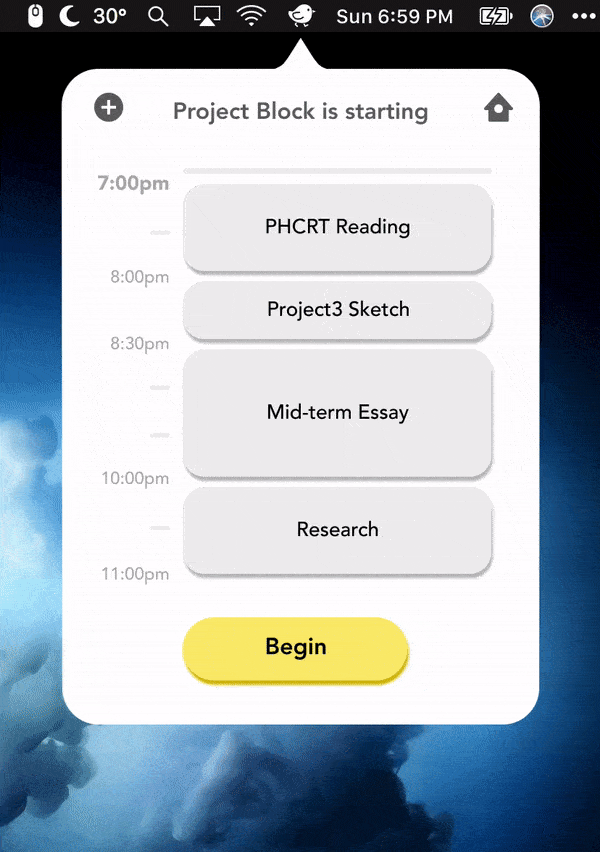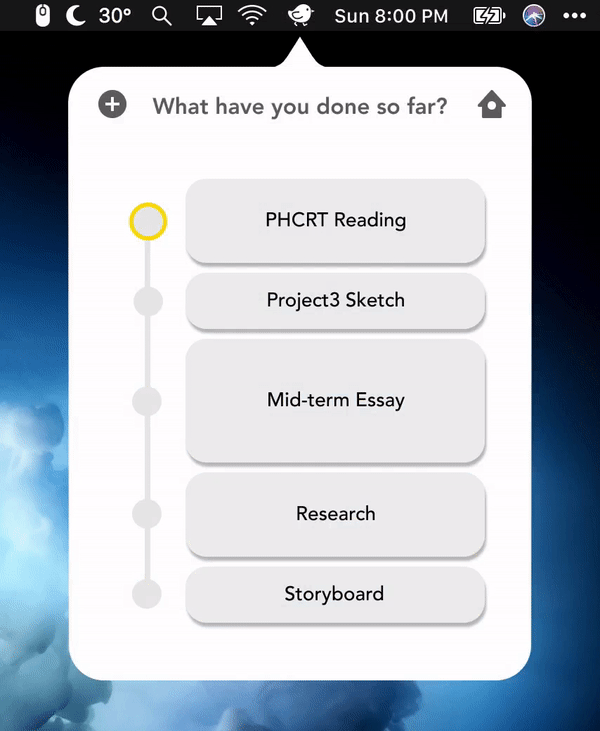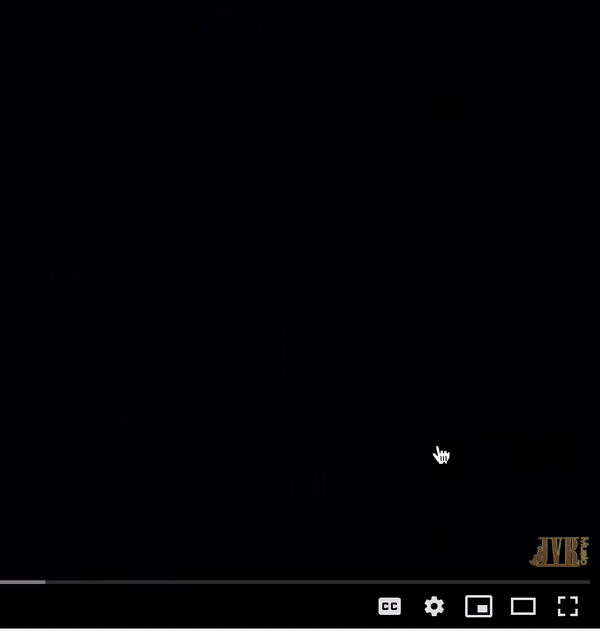"Wellness is something I do for myself.
We just need some support along the way."
Background
I joined a group of 3 with complementary background and skillsets to build this product.
In 5 days, we tried to identify a specific problem in the Digital Wellbeing space that's relevant to us and our potential users, and created an digital experience with prototypes.
Understand User
Auto-ethnographies started us on our initial problem statement, "I feel enslaved to technology because it distracts me with unimportant messages."
Our sketch storm hypothesized that people could not resist digital devices because of an Inbox Zero complex, needing to check all notifications on the chance they would miss something important or feeling anxious over an unresolved task.
Through interviews to uncover what motivates wellness habits, we found our research subjects all had well-defined ideas of where technology was useful in their lives. What is important/urgent to the user is highly subjective and varies only by degrees across situations, whereas their susceptibility to digital entrapment fluctuates markedly by context. They most struggle with discipline breakdown in non-professionally structured time, where they become susceptible to the ease of a newsfeed or a play universe.
Our direction pivoted from prioritization of messages toward how we might shift default behaviors.
_edited.jpg)
Problem Statement sharing & Affinity Mapping
Define Problem
"Open my phone/computer when I open my eyes, close when I close my eyes."
Technology helps with organizing one’s life to achieve goals that are:
nourishing, replenishing, productive, balanced, fulfilling and centering.
The biggest pain point remain in digital addiction, particularly during non-work hours.

Diagrams and sketches helped consolidate our problem statement
Opportunities
Each team member interviewed 3-4 potential users to understand why, despite technology’s usefulness, it failed them.
We shared out our findings & HMW notes. The opportunities were then grouped into categories to be voted. These categories helped provide a structure for understanding the problem space and identifying areas to sketch ideas for solutions.

_edited.jpg)
Generating a broad range of ideas for potential solutions in a time-boxed format
Insights
Users
-
value technology that helps them accomplish goals
-
most struggle with digital discipline in non-professionally structured time
-
are especially susceptible to the ease of news feed/game media
-
don’t like being controlled
How might we
Use technology to
-
make goals more achievable
-
customize mental spaces
-
shift default behaviors
-
restore intentionality
Design Solution
We started by a storyboard, added "killer" ideas and validated them by concept testing with other teams. Via whiteboarding the experience mapping, we digested those feedbacks and strengthened our storyboard.
_JPG.jpg)

Digitalized by Laura
What should the product be able to do?
How will it do them?
Design Principles
-
Qualities: Dependable, Customizable, Attentive, Reassuring, Pleasing, [Finite]/self-managing/contained
-
Mechanism that they can't hate (nature vines) + where they won't feel infantilized.
Value Proposition
Personable to match the mercurial personalities of humans who use it with right-on-time communication.
Concepts
-
[Study/Workout] Buddy: monkey see, monkey do
-
Reset escalation/ease-in, on-ramp mind shift for productivity
-
Natural imagery elapsing + reminders of a world outside the digital
-
Mental spaces: customize assists
-
Reward growth/tending (garden/farm) to routine
Strategy
Intercept + Redirect
Fortify with psychological tactics:
-
having a virtual accountability partner provide reminders and role-modeling
-
encouraging users to consciously articulate helpful and hurtful environmental factors whose self-wisdom is called up when their attention wavers
-
making vices less enticing / triggering mental resets
-
activating the reward center of validating their efforts moving incrementally together toward their habit goals.
Prototype
Together we mapped out the user flow based on our storyboards and started wireframing in Figma. One of the teammate and myself who had some visual skills worked on the UI and prototype animation.
Introducing Aibo
Aibo is a virtual “sidekick” tool that helps users achieve balanced digital-IRL habits.
By providing smart redirects away from bad influences and customized morale “power-ups” and validating progress toward desired behaviors, with either the tough or cheerful hand of an attentive friend, Aibo acts as a steadfast accountability partner to help them achieve their habit goals.


Tool Set-up
by connecting with your calendar.
Start


Identify
habits you want to build, and tap on the block to customize “Power-ups” to helps you stay in flow with that “brain space.”
any tricky apps and sites that have led to distraction on the Watchlist.
Flag

your work versus non-work hours
Set






User Scenario
Devon started using Aibo to stay motivated on a personal project that he does outside of work.
Set incremental tasks
When his calendared project block is about to start, Aibo knows we will need some help keeping focused, and suggests breaking it down into smaller tasks.
Check off
completed tasks
The first milestone is up.
How are we doing?
Manage distractions
After finishing a couple tasks, Devon wanders into Youtube, a distractor flagged in their Watchlist, but he needs to access it for his project.
What are we looking for? Minutes later he’s already enticed into free browsing. That’s right, we had set a mission for ourselves!
Power-up
Halfway through, Devon can use some encouragement. Stretching sounds like a good idea!
Reschedule
We stayed the course through our project block with a task still on the list, and Devon is reminded that staying up late glued to the screen never felt as good as coming back refreshed after a night’s rest.
With our next block scheduled, we can relax now.
Diagrams
Concept Map
Drafted by Laura, revised by me

Main User Flow Map
Drafted by myself, reviewed by the team

Learnings & Next Step
Insight
Intrinsic motivation is built over time via small accomplishments which merits reminder. The psyche is delicate and has greater success with positive validation and when reachable achievements are of the immediate term / in-sight—progress over destination. Surprised to learn that productivity could be considered part of Wellness, when wellness is often framed as "unplugging" or going offline.
Feedback
Our reviewer suggested considering deeper integration with Google suite - particularly Gmail Tasks. Some of the teams wondered whether our focus on the different mindset a person has during off-work hours (when they are trying to distance from email/task management) needed clearer emphasis, or if perhaps further research could inform our theory.
Reflection
We also identified a parallel opportunity of using these tactics to enable physical-in-world habits, but due to time constraints, focused on the fundamental pain point of difficulty extricating from digital media where everyday business necessitates slippery-slope contact with personal devices.
Want to explore further: (creativity/meditation yet active), “brain journey out” vs passivity, How wellness relates to our perception of our own self-worth. With additional time, we would’ve liked to investigate more social/gaming aspects.
